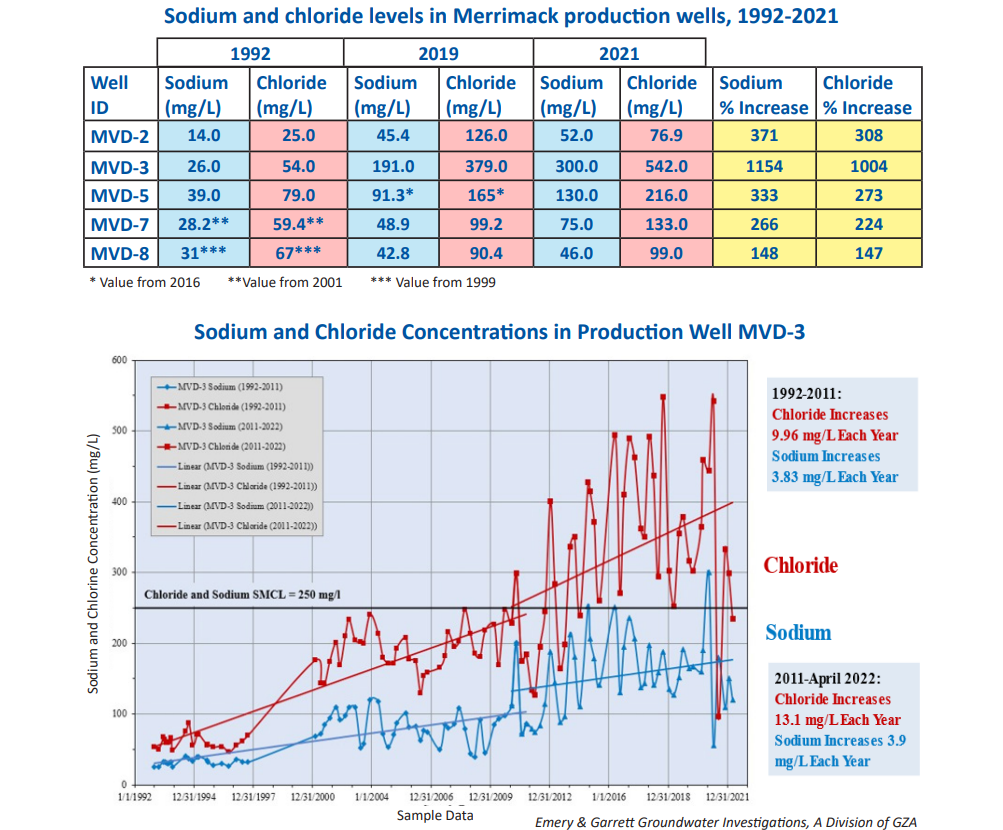Insights
What’s More Expensive to Treat Than PFAS, VOCs and Metals Combined?
At a Glance
This story was originally published by NHDES Supply Lines with The Source.
Merrimack Village Water District (MVD) relies on six high-yield wells located in stratified-drift deposits in and
around Merrimack to supply nearly one billion gallons of water annually to over 9,300 service connections.
Over the past 30 years, sodium and chloride levels have substantially increased in all of MVD’s production wells.
As shown in the table and graph below, sodium in well MVD-3 has risen 1,154% to 300 ppm and chloride has risen
1,004% to 542 ppm since 1992. Consequently, this well is currently being used as an emergency source only. The cost
of treatment for sodium and chloride is substantially higher than that of PFAS, VOCs and/or metals combined. Reducing salt use on roads and parking areas in the Wellhead Protection Areas (WHPAs) of the MVD production wells is no
longer a choice in Merrimack, it simply must happen.
To reduce salt use, MVD has initiated the following efforts focused on “changing the culture” in how we think about salt:
- With a Local Source Water Protection Grant from NHDES, MVD hired Emery & Garrett Groundwater Investigations (EGGI) to evaluate salt loading practices in their WHPAs and develop a Salt Mitigation Plan.
- Per the Plan, the Merrimack Planning Board placed more salt restrictions on new construction projects (e.g., Premium Outlet Mall) within the WHPAs. For grandfathered sites, letters were sent to each business that had salt use restrictions notifying them as to whether they were in compliance with their site plan and encouraging all others to reduce their salt use. Bulk mailings were sent to all residents within the WHPAs regarding the need to reduce the use of sodium and chloride on their driveways and walkways.
- EGGI prepared a presentation on the use of anti-icing methods versus simply deicing, and the advantages of using less salt on roads and parking lots in WHPAs. This was presented to the Town Council, Planning Board, NHDES, local stakeholders, commercial parking lot owners, and the Public Works Department (DPW).
- MVD formed a Salt Reduction Committee - comprising citizens, public agencies, landscape contractors, property managers, facilities mangers, NHDES and EGGI - to work toward reduced salt use in all WHPAs.
- MVD now works directly with some of the largest parking lot owners in WHPAs to change their winter maintenance practices.
- MVD and EGGI provided a presentation on the salt load issues in Merrimack to a statewide audience.
- MVD is working with the Merrimack DPW on salt use practices in WHPAs.
- With another NHDES Local Source Water Protection Grant, MVD, in conjunction with the DPW, will install 60-70 signs notifying motorists that they are entering a WHPA, and that salt use may be reduced.
Time will tell whether these efforts result in reducing salt loads in WHPAs. A groundwater monitoring program is in place
to measure the effectiveness of these efforts. Data will be presented to MVD and the Town on a semiannual basis. The
alternative to reducing salt loading sufficiently would be spending tens of millions of dollars.

